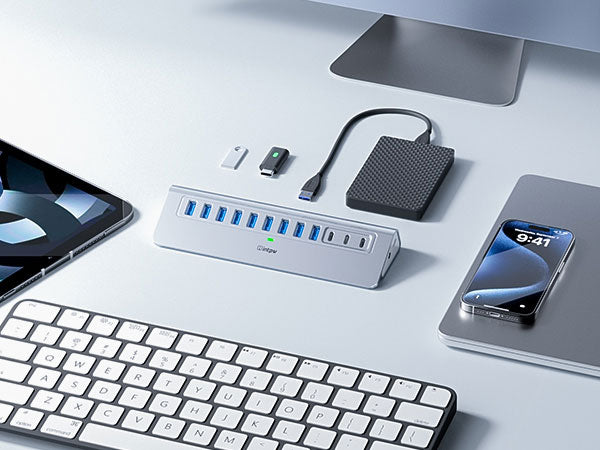
The Future of USB Hub Technology: From USB4 to Wireless Connectivity
, by USintpw, 6 min reading time

, by USintpw, 6 min reading time
USB hubs have become essential tools for connecting multiple devices to laptops, tablets, and desktops. As technology evolves, USB hubs are also advancing, incorporating faster speeds, more powerful features, and even wireless options. These innovations aim to keep up with the growing demands of modern users who need seamless connectivity across a wide range of devices.
This blog explores the future of USB hub technology, focusing on the transition to USB4, the rise of wireless connectivity, and the exciting possibilities ahead.
A USB hub is a device that expands the number of USB ports on your computer. It acts as a central hub, allowing you to connect multiple peripherals such as keyboards, mice, monitors, printers, and external drives. Over the years, USB hubs have evolved, offering faster speeds, better compatibility, and additional features like power delivery and data transfer capabilities.
The next generation of USB hubs promises to push these advancements even further, making them indispensable for professionals, students, and everyday users alike.
USB4 is the latest USB standard, offering speeds of up to 40Gbps—double that of USB 3.2. This means you can transfer large files, such as 4K videos or extensive backups, in seconds. USB hubs designed for USB4 will enable users to connect high-speed external drives, cameras, and other devices without any bottlenecks.
For example:
USB4 hubs support advanced display protocols, including dual 4K monitors or a single 8K display. This is particularly valuable for multitaskers who need extra screen space for productivity or gamers seeking immersive experiences.
With USB4 hubs, you can:
USB4 hubs are backward compatible with USB 3.2, USB 3.0, and even USB 2.0. They also support Thunderbolt 3 devices, creating a unified ecosystem where users can connect almost any peripheral. This universal compatibility simplifies connectivity, reducing the need for multiple adapters or specialized cables.
USB4 hubs deliver up to 100W of power, making them ideal for charging laptops, smartphones, and other devices. This feature eliminates the need for separate chargers, creating a cleaner and more organized workspace.
One of the most exciting developments in USB hub technology is the move toward wireless connectivity. Wireless USB hubs allow users to connect devices without relying on physical cables. These hubs use technologies like Wi-Fi, Bluetooth, or ultra-wideband (UWB) to create a seamless connection between devices.
For example:
Wireless hubs are compact and portable, making them perfect for users on the go. They are especially useful for mobile workers who need to connect multiple devices in different locations.
Imagine carrying a wireless USB hub in your bag and instantly creating a workstation wherever you are—at a café, coworking space, or airport lounge.
While wireless hubs are promising, they face challenges like latency, interference, and limited bandwidth. However, ongoing advancements in wireless technology are addressing these issues. Emerging standards like Wi-Fi 6 and Wi-Fi 7 are expected to enhance the reliability and speed of wireless USB hubs, making them viable for demanding tasks like gaming and video editing.
USB hubs are becoming smarter, integrating with IoT (Internet of Things) devices and smart home ecosystems. Future hubs might:
These intelligent features will make USB hubs more than just connectors—they’ll become central hubs for managing your digital life.
As technology advances, USB hubs are becoming smaller and more aesthetically pleasing. Future hubs will combine functionality with style, fitting seamlessly into modern workspaces.
Sustainability is a growing focus in tech design. USB hubs of the future may incorporate recycled or biodegradable materials, reducing their environmental impact.
Imagine a USB hub that allows you to customize its features by snapping on additional modules. Need an SD card reader or an extra HDMI port? Just attach the relevant module. This modular approach could revolutionize how we use USB hubs, offering unmatched flexibility.
With USB4 and wireless capabilities, photographers, videographers, and designers can connect high-speed drives, 8K monitors, and other devices simultaneously. This streamlines workflows and enhances productivity.
Low-latency wireless hubs will enable gamers to connect peripherals like controllers, keyboards, and headsets without worrying about lag. USB4 hubs will also support advanced graphics features, creating a more immersive gaming experience.
As remote work becomes the norm, USB hubs will play a vital role in creating efficient home office setups. Features like wireless connectivity and multi-monitor support will make them indispensable tools for productivity.
The future of USB hub technology is bright, with innovations like USB4, wireless connectivity, and smart integration redefining how we use these devices. As our reliance on technology grows, USB hubs will continue to evolve, becoming faster, more versatile, and easier to use.
Whether you’re a professional, gamer, or casual user, these advancements will enhance your digital experience, making USB hubs more than just a convenience—they’ll be essential tools for productivity and connectivity.
So, keep an eye on the latest developments and embrace the future of USB hub technology. It’s a future where speed, flexibility, and innovation come together to create the ultimate connectivity experience.

Subscribe to our emails